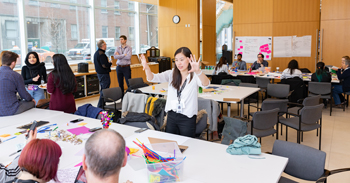New workshop series aims to improve the hospital experience

By Amber Daugherty

Could hospitals take some cues from spas on how to welcome patients and help them feel more relaxed during their stay?
Providing patients with ear plugs and a face mask could improve the hospital experience and avoid some readmissions, suggested a group of students, staff members and patients at a design thinking workshop series.
It was just one recommendation that came from brainstorming about ways to improve systems and processes by first considering how the end user – in this case the patient – would benefit.
“Medical professionals talk to patients all the time about how they’re feeling but rarely do they ask how we can better design the spaces they receive that care in and how we can improve their experience,” said Rushil Chaudhary, a fourth year medical student from the University of Toronto who led the workshop series.
He got the idea to host these after seeing on Twitter that Dr. Andrew Petrosoniak, an emergency room physician and trauma team leader at St. Michael’s, had recently attended a design thinking workshop at Jefferson University in Philadelphia.
Chaudhary had never done design thinking work through his schooling and thought it was something he and his fellow students might benefit from.
And then Chaudhary found his topic: Dr. Amol Verma from St. Michael’s led a study that found patients who had disturbances in their mood, sleep, nutrition or mobility while in the hospital were more likely to return within 30 days – often for something unrelated to what they had previously been there for.
“We worked out this model where we would bring students – medical, engineering and architecture – together with staff from the hospital and Patient and Family Advisors to think about how we could address this issue,” Chaudhary said of working with Dr. Petrosoniak, Sean Molloy, director of quality, patient safety and innovation, and Melissa McGowan, research education coordinator for the emergency department, on designing the workshops.
The workshops were a success because of the people in the room, including Patient and Family Advisors, said Molloy.
“You can’t design new experiences in health care without patients and families. They brought their experience of what it’s really like to be on a busy, loud unit and they were part of the design process helping us ensure that we created solutions that met their needs.”
In addition to hearing stories directly from former patients and family members, the students were also able to experience firsthand the noise and traffic that can often be found in an inpatient bed through virtual reality videos created by Chaudhary and Dr. Petrosoniak. They also arranged for a tour of one of the hospital’s busiest units.
“This was a large team effort,” said Molloy. “Our general internal medicine team allowed us to see the space they work in every day and then took part in the workshop helping design solutions. Leighanne Mackenzie, program director, inner city health, Susan Camm and Kim Grootveld, clinical manager leaders and Shirley Bell, clinical nurse educator, were essential in helping pull this together and now have some new ideas to take back to their floor.”
At the end of the workshops, Chaudhary and Dr. Petrosoniak said they hoped the students had a new way of thinking through issues they encounter.
“Clinical trials are great when you have two drugs and are comparing but when we’re talking about improving someone’s experience during their hospitalization, a randomized control trial won’t solve that problem,” said Dr. Petrosoniak.
“Design thinking is a pretty powerful tool because it centres on the human experience, in this case, the patient experience. What we typically think are the issues, often aren’t the real problem when we actually speak to patients. Once we work with them to understand their perspective and experience, together with them we can design meaningful solutions. We hope to share with future leaders in medicine that there might be a different way of approaching issues. By getting students excited about that, we hope that maybe it will spark someone in the future to think differently.”
Someone, perhaps, like Matt Breton, who is in his fourth year of medical training at the University of Toronto. This was his first introduction to design thinking and he was part of the team who came up with the eye mask and ear plug idea.
“Not only does this exercise help us put ourselves in patients’ shoes, it’s also allowing us to use our creativity to problem solve,” he said.
“I think it’s a great model to use for thinking about problems that don’t have clear-cut solutions.”
About St. Michael’s Hospital
St. Michael’s Hospital provides compassionate care to all who enter its doors. The hospital also provides outstanding medical education to future health care professionals in more than 27 academic disciplines. Critical care and trauma, heart disease, neurosurgery, diabetes, cancer care, care of the homeless and global health are among the Hospital’s recognized areas of expertise. Through the Keenan Research Centre and the Li Ka Shing International Healthcare Education Centre, which make up the Li Ka Shing Knowledge Institute, research and education at St. Michael’s Hospital are recognized and make an impact around the world. Founded in 1892, the hospital is fully affiliated with the University of Toronto.
About Unity Health Toronto
Unity Health Toronto, comprised of Providence Healthcare, St. Joseph’s Health Centre and St. Michael’s Hospital, works to advance the health of everyone in our urban communities and beyond. Our health network serves patients, residents and clients across the full spectrum of care, spanning primary care, secondary community care, tertiary and quaternary care services to post-acute through rehabilitation, palliative care and long-term care, while investing in world-class research and education. For more information, visit www.unityhealth.to.
